主语和谓语的一致教学教材
【语法课件】谓语动词的时态、语态和主谓一致

doing
been doing have been doing
1.一般时态 (1)一般现在时 ①表示经常或习惯性的动作,多用动作动词,且常与表频率的时间状语连用。 We have meals three times a day.我们一日吃三餐。 ②表示客观真理、科学事实及自然现象。 The sun sets in the west.太阳从西方落下。 ③在时间、条件状语从句中常用一般现在时代替一般将来时。 I'll write to her when I have time. 有时间我会写信给她。
②一般将来时的常用结构
·用于“I expect,I'm sure,I think,I wonder+宾语从句”中 ·用于“祈使句+and+陈述句”中 ·与表示时间或条件的状语从句连用
Don't worry about the exam.I'm sure you'll pass. 不要担心这次考试,我确信你会通过的。 If you ask him,he will help you. 如果你请他帮忙,他会帮助你的。
③ 表 示 位 置 转 移 的 动 词 可 用 进 行 时 代 替 将 来 时 。 这 样 的 动 词 有 go , come , start,leave,arrive,begin,return等。 I'm leaving for Beijing next month. 我下个月要去北京。 (2)过去进行时(was/were+现在分词) 过去进行时表示在过去某个时刻或某段时间正在进行的动作或存在的状态。 He was reading an interesting book this time yesterday. 昨天这个时候他在读一本有趣的书。
大学主谓一致教案
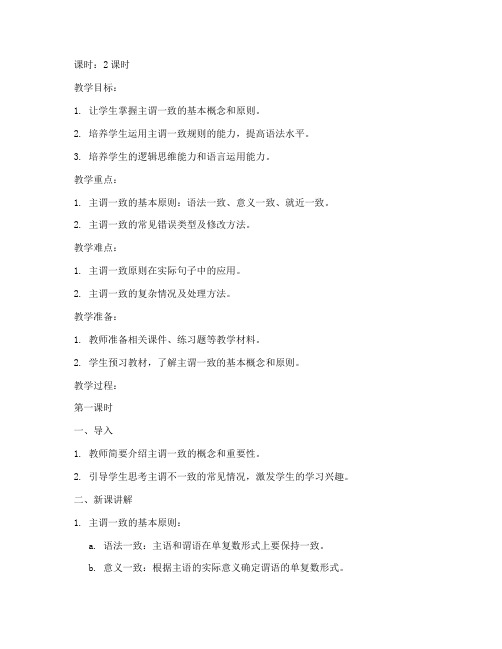
课时:2课时教学目标:1. 让学生掌握主谓一致的基本概念和原则。
2. 培养学生运用主谓一致规则的能力,提高语法水平。
3. 培养学生的逻辑思维能力和语言运用能力。
教学重点:1. 主谓一致的基本原则:语法一致、意义一致、就近一致。
2. 主谓一致的常见错误类型及修改方法。
教学难点:1. 主谓一致原则在实际句子中的应用。
2. 主谓一致的复杂情况及处理方法。
教学准备:1. 教师准备相关课件、练习题等教学材料。
2. 学生预习教材,了解主谓一致的基本概念和原则。
教学过程:第一课时一、导入1. 教师简要介绍主谓一致的概念和重要性。
2. 引导学生思考主谓不一致的常见情况,激发学生的学习兴趣。
二、新课讲解1. 主谓一致的基本原则:a. 语法一致:主语和谓语在单复数形式上要保持一致。
b. 意义一致:根据主语的实际意义确定谓语的单复数形式。
c. 就近一致:当主语由多个词构成时,谓语动词的形式取决于最靠近它的主语。
2. 主谓一致的应用:a. 集体名词作主语时,根据集体名词的实际意义确定谓语的单复数形式。
b. 名词作主语时,根据名词的复数形式确定谓语的单复数形式。
c. 不定代词、数词、量词等作主语时,根据其意义确定谓语的单复数形式。
三、课堂练习1. 教师出示练习题,学生独立完成。
2. 教师讲解练习题,分析错误原因,纠正学生错误。
四、总结1. 教师总结本节课所学内容,强调主谓一致的重要性。
2. 布置课后作业,巩固所学知识。
第二课时一、复习导入1. 教师提问上节课所学内容,检查学生对主谓一致原则的掌握情况。
2. 引导学生回忆主谓不一致的常见错误类型。
二、新课讲解1. 主谓不一致的常见错误类型及修改方法:a. 误用单复数:根据主语的实际意义确定谓语的单复数形式。
b. 误用主谓一致原则:根据主谓一致的基本原则进行修改。
c. 误用就近一致原则:根据就近一致原则进行修改。
2. 复杂情况及处理方法:a. 名词作主语时,根据名词的复数形式确定谓语的单复数形式。
小学语文教案:语法中的主语与谓语

小学语文教案:语法中的主语与谓语一、主语与谓语的定义和作用主语和谓语是语法中最基础的两个概念,它们在句子中起着至关重要的作用。
主语一般指出句子的动作发出者或者所说对象,而谓语则指出动作或状态的发生与否。
在教学过程中,对于小学生而言,理解和掌握主语与谓语的概念是构建正确句型和表达准确意思的基础。
下面将详细介绍主语和谓语的定义、功能及其教学方法。
二、主语的定义及其功能1. 主语的定义主语是指表示一个事物或者人物的词或短词组,它通常位于句子结构中的最前面,回答“谁?”或“做什么?”等问题。
根据不同句子类型,主语可以是单个名词、代词、名词短语等。
2. 主语在句子中扮演着重要角色(1)确定动作或状态发出者:主题能够使我们明确地了解到谁在进行某个动作或产生某种状态。
例如,“小明跑步”这个句子中,“小明”就是动作“跑”的发出者。
(2)引导补充信息:主语可以帮助我们补充更多相关的信息。
例如,“小狗在湖边玩耍”的句子中,“小狗”不仅表示这个动作是由小狗实施的,还可以进一步了解到它在哪里进行了这个动作。
三、谓语的定义及其功能1. 谓语的定义谓语是句子中用来说明主语所表达的动作或者状态,以回答“做什么?”、“怎样?”等问题。
谓语一般位于主语之后,包括动词、形容词、名词性成分等。
2. 谓语在句子中的重要作用(1)描述或说明动作:通过谓语的使用,我们能够清楚地了解到主题发生了什么样的动作。
例如,“他吃饭”这个句子中,“吃”就是描述主题进行的重要活动。
(2)表示状态或特征:除了描述动作外,谓语还可以帮助我们表达事物或人物具有某种特定状态或特征。
例如,“天空飘着白云”中,“飘着”表示天空当前所呈现出来的状态。
四、教学方法与技巧1. 通过游戏引导学习对于小学生而言,让他们通过游戏的方式学习主语和谓语是一种趣味且有效的方法。
可以利用课堂上的道具或图片,让学生担任不同角色进行对话,引导他们寻找句子中的主语和谓语。
这样能够加深学生对主谓概念的理解,使他们通过实际操作更好地记忆并运用于实际交流中。
高三英语语法“主谓一致”公开课教学设计

高三英语语法“主谓一致”公开课教学设计以下是关于高三英语语法“主谓一致”公开课教学设计,希望内容对您有帮助,感谢您得阅读。
高三英语语法“主谓一致”公开课教学设计原创:翟艳丽黑龙江高中英语翟艳丽名师工作室设计教师:翟艳丽教学年级:高三年级主谓一致教材版本:外研社版课题名称:语法教学《主谓一致》授课时间:45分钟(一)学情分析“主谓一致”属于复习的语法知识,但是其中所涉及的知识点较多,学生们在准确性及熟练程度还有所提高,他们往往出现易混嚼、难辨别的问题。
针对这一情况,采用导学案形式,集中大容量呈现知识点,并着重强调易混部分,强化学生对“主谓一致”规则的记忆。
提高他们学习知识的积极性。
(二)教材分析主谓一致是我们英语教学中的很重要的一个语法,掌握主谓一致对于学生的英语学习有着至关重要的作用,它渗透到了高考英语的每一部分,特别是在写作和改错部分,如果学生在“主谓一致”这一部分掌握不好,在高考中会失分很多的。
所以我在此课中,在很大比例中加入了高考题的链接,激励学生·认真仔细剖析高考题,以便于更好地理解把握“主谓一致”的规则和用法。
(三)教学目标新课标中明确指出:语法教学就是帮助学生提高语言实践活动中的能力。
本节课的教学目标为:激励学生将语法“主谓一致”真正落到实处,学会正确使用与主语一致的谓语动词。
(1)语言知识目标:准确记忆,灵活掌握“主谓一致”相应的规则。
(2)语言技能目标:培养学生在综合实践活动中对“主谓一致”语法规则的运用。
(3)情感态度目标:培养学生的自主学习能力以及合作探究能力。
(4)学习测略目标:主谓一致中的语法规则里需要揣测和理解的,所以这节课我着重帮助学生养成自主探究。
研究归纳语法规则的能力,促使他们保持课前预习,课上合作研究的良好学习习惯。
(四)教学重点、难点重点:①准确理解并掌握在同情况下谓语动词单复数的选择,全面记忆和使用主谓一致规则。
②在实际活动中,正确运用“主谓一致”原则。
《主谓一致》ppt课件

当主语为“there be”句型时,谓语动词的单复数形式 要与最靠近的主语保持一致。
错误示例
Either you or he is right.
纠正方法
将动词改为单数形式,正确句子为Either you or he is right.
注意事项
当主语由either...or、neither...nor、not only...but also等连接时,谓语动词的单复数形式要与最靠近的主 语保持一致。
存在句和there be句型中主谓一致问题
存在句中的谓语动词要与存在的主语保持一致。
there be句型中,be动词的单复数形式要与后面主语的单复数形式保持 一致。
如果存在的主语是不可数名词或单数可数名词,则be动词用单数形式; 如果存在的主语是复数可数名词,则be动词用复数形式。
倒装句中主谓一致问题
04
特殊情况下主谓一致 规则解析
并列主语情况下主谓一致问题
由and连接的并列主语,谓语动词用复数形式。
由or, nor, either...or, neither...nor, not only...but also连接的并列主语,谓语动词与最近的 主语保持一致。
主语后面跟有as well as, as much as, no less than, along with, together with, rather than, except, but, besides, including, in addition to等引导的词组时,其谓语动词的单 复数形式依主语的单复数而定。
常见的不可数名词包括water, milk, bread, money等。
即使不可数名词前有表示数量 的复数名词修饰,谓语动词仍 用单数形式。
小学语文教案:语法中的主语与谓语

小学语文教案:语法中的主语与谓语一、引言语文是小学生学习中的重要科目之一,其中语法的学习对于学生的语言表达能力的提升具有重要意义。
而语法中的主语与谓语作为句子中最基本的成分,不仅在句子构成中起到关键作用,同时也对学生理解和运用句子的结构和语义起着至关重要的作用。
二、主语的认识与理解1. 主语的定义主语是句子中最重要的成分之一,它通常是句子的话题或行为的执行者。
主语在句子中起到句子表达语意的核心作用,是句子中的重要角色。
例如:“小明吃了一个苹果。
”中,“小明”就是这个句子的主语。
2. 主语的种类主语可以分为以下几种种类:(1)名词性主语:通常是一个名词或代词,例如:“他是一位好老师。
”中,“他”就是名词性主语。
(2)动词性主语:通常是一个动词的不定式或动名词,例如:“游泳对健康有好处。
”中,“游泳”就是动词性主语。
(3)句子型主语:通常是一个完整的句子,例如:“回家才是最重要的。
”中,“回家”就是句子型主语。
三、谓语的认识与理解1. 谓语的定义谓语是句子中用来说明主语动作、状态、情感等的部分。
谓语通常是一个动词或动词短语,它与主语之间是一种紧密的关系,是句子中重要的组成部分。
例如:“小明在跑步。
”中,“在跑步”就是这个句子的谓语。
2. 谓语的种类谓语可以分为以下几种种类:(1)及物动词谓语:谓语后面需要有一个宾语才能构成完整的句子,例如:“他喜欢看电影。
”中,“喜欢看电影”就是及物动词谓语。
(2)不及物动词谓语:谓语后面不需要宾语即可构成完整的句子,例如:“他睡觉。
”中,“睡觉”就是不及物动词谓语。
(3)系动词谓语:谓语后面需要一个表语来说明主语的状态、性质等,例如:“这个苹果很甜。
”中,“很甜”就是系动词谓语。
四、主语与谓语的搭配1. 主谓一致主谓一致是指主语和谓语在人称、数、时态等方面相互匹配的关系。
例如:“我喜欢运动。
”中,“我”是第一人称单数,所以谓语“喜欢”也要用第一人称单数形式。
2. 主谓搭配规则在中文语法中,主谓搭配有一定的规则,例如:(1)主语是两个或两个以上并列的名词时,谓语一般与最近的名词保持一致。
高考英语主谓一致(菲斯特外语学校专用教材之节选)

贵阳菲斯特外语学校专用教材节选之一地址:贵阳云岩区下合群路达亨大厦13楼电话:6572167 6576031第五章主谓一致主谓一致即谓语动词必须在人称和数上与主语一致。
在判断一个句子主语是否一致时,要遵循下列三个原则:语法是否一致、意义是否一致以及临近的词语在语法关系、搭配关系、语意组合等方面是否一致。
一、名词作主语与谓语的一致考查考点1. 集合名词public, family, team等作主语时,如果表示整体概念,谓语动词用单数;如表示成员则用复数。
例:My family lives in Shanghai.我家住在上海。
My family are all fond of the program.我的家人都喜欢这个节目。
常见的这部分名词有:army, audience, class, club, committee, company, crowd, couple, family, group, government, jury, party, personnel, staff, team, union, public等。
注:有的集合名词如folk, people, police, cattle等作主语时,表达复数概念。
例: The people in the city are friendly.那个城市的人非常友好。
The police have caught the criminal.警察已经逮捕了那个罪犯。
考点2. 单复数同形的名词作主语,要根据意义来决定谓语的形式。
常见的这部分名词有:aircraft, deer, fish, means, sheep, species, series, works, crossroads, headquarters等。
例:The species of fish are numerous.鱼的种类繁多。
This species of rose is very rare.这种玫瑰花很稀罕。
高中英语_主谓一致教学设计学情分析教材分析课后反思
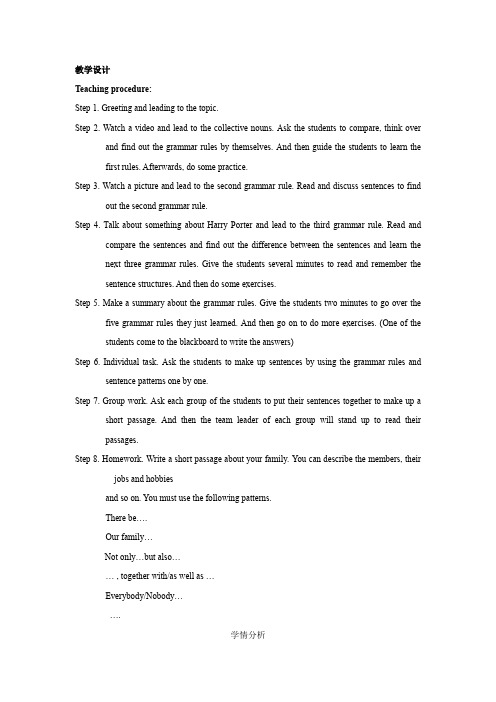
教学设计Teaching procedure:Step 1. Greeting and leading to the topic.Step 2. Watch a video and lead to the collective nouns. Ask the students to compare, think over and find out the grammar rules by themselves. And then guide the students to learn the first rules. Afterwards, do some practice.Step 3. Watch a picture and lead to the second grammar rule. Read and discuss sentences to find out the second grammar rule.Step 4. Talk about something about Harry Porter and lead to the third grammar rule. Read and compare the sentences and find out the difference between the sentences and learn the next three grammar rules. Give the students several minutes to read and remember the sentence structures. And then do some exercises.Step 5. Make a summary about the grammar rules. Give the students two minutes to go over the five grammar rules they just learned. And then go on to do more exercises. (One of the students come to the blackboard to write the answers)Step 6. Individual task. Ask the students to make up sentences by using the grammar rules and sentence patterns one by one.Step 7. Group work. Ask each group of the students to put their sentences together to make up a short passage. And then the team leader of each group will stand up to read their passages.Step 8. Homework. Write a short passage about your family. You can describe the members, their jobs and hobbiesand so on. You must use the following patterns.There be….Our family…Not only…but also…… , together with/as well as …Everybody/Nobody…….学情分析通过高中一年的学习,学生对于主语和谓语动词的一致知识有了一定的积累,但是对于他们的内部联系和规律依然不是很清晰,尤其是各种特殊名词和各种特殊句式之间的内在联系,学生很容易混淆,所以说很有必要引领学生把英语的主谓一致语法项目进一步系统化。
第十六章主谓一致主谓一致(concord),是指主语和谓语动词要保持人称
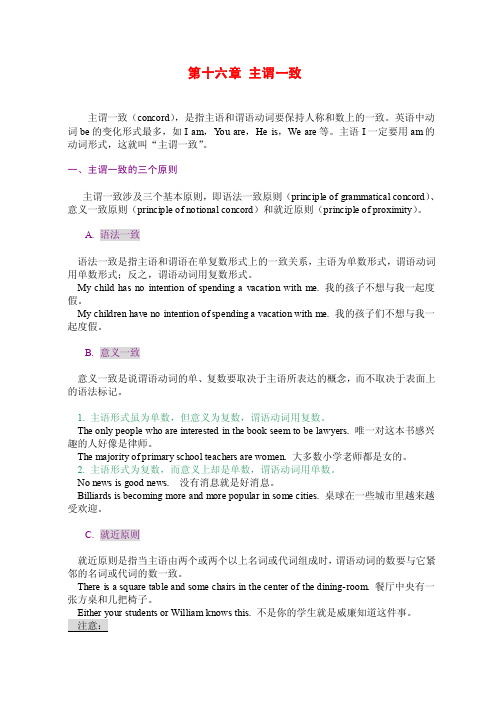
第十六章主谓一致主谓一致(concord),是指主语和谓语动词要保持人称和数上的一致。
英语中动词be的变化形式最多,如I am,Y ou are,He is,We are等。
主语I一定要用am的动词形式,这就叫“主谓一致”。
一、主谓一致的三个原则主谓一致涉及三个基本原则,即语法一致原则(principle of grammatical concord)、意义一致原则(principle of notional concord)和就近原则(principle of proximity)。
A.语法一致语法一致是指主语和谓语在单复数形式上的一致关系,主语为单数形式,谓语动词用单数形式;反之,谓语动词用复数形式。
My child has no intention of spending a vacation with me. 我的孩子不想与我一起度假。
My children have no intention of spending a vacation with me. 我的孩子们不想与我一起度假。
B.意义一致意义一致是说谓语动词的单、复数要取决于主语所表达的概念,而不取决于表面上的语法标记。
1. 主语形式虽为单数,但意义为复数,谓语动词用复数。
The only people who are interested in the book seem to be lawyers. 唯一对这本书感兴趣的人好像是律师。
The majority of primary school teachers are women. 大多数小学老师都是女的。
2. 主语形式为复数,而意义上却是单数,谓语动词用单数。
No news is good news. 没有消息就是好消息。
Billiards is becoming more and more popular in some cities. 桌球在一些城市里越来越受欢迎。
C.就近原则就近原则是指当主语由两个或两个以上名词或代词组成时,谓语动词的数要与它紧邻的名词或代词的数一致。
主谓一致之就近与就远一致原则教学设计
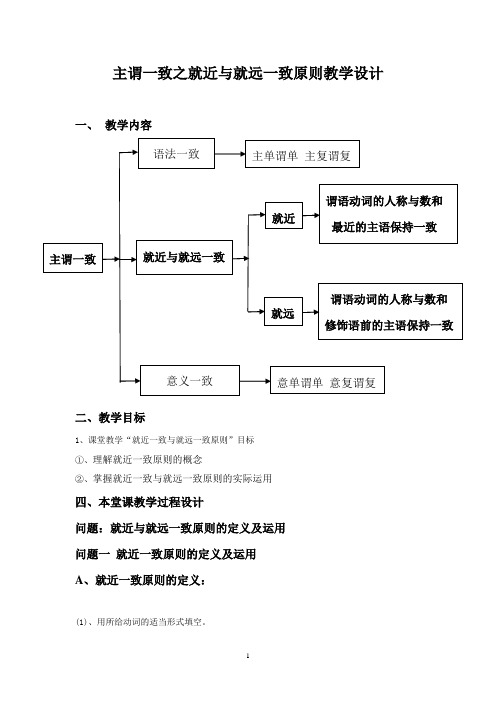
主谓一致之就近与就远一致原则教学设计一、教学内容二、教学目标1、课堂教学“就近一致与就远一致原则”目标①、理解就近一致原则的概念②、掌握就近一致与就远一致原则的实际运用四、本堂课教学过程设计问题:就近与就远一致原则的定义及运用问题一就近一致原则的定义及运用A、就近一致原则的定义:(1)、用所给动词的适当形式填空。
Group 1:1)、Here ________ a pen and two books for you.(be)2)、There __________ two apples and six bananas on the desk.(be)3)、Neither you nor I __________ wrong.(be)4)、Not only the students but also the teacher ___________ listening to the music.(enjoy)5)、Either you or your sister ___________ to wash clothes.(have)6)、Tom or you ___________ going to win.(be)设计意图:通过实例呈现就近一致原则的语法现象,学生首先通过填充谓语动词对就近一致原则的定义有了一个初步的了解,解决了这个问题就为之后的观察句子,总结就近一致原则的适用范围做好了铺垫。
师生活动:学生独立思考完成谓语动词的填空后回答。
定义总结:就近一致原则指的是谓语动词的人称和数由最靠近它的主语决定。
B、就近一致原则的运用(2)、观察以上六个句子,总结就近一致原则的适用范围。
设计意图:进一步从句子的主语和谓语两部分来归纳就近一致原则的适用范围。
师生活动:学生讨论后回答,教师指导。
运用总结:A、当用作主语的两个名词或代词由or,either...or, neither...nor, not only...but also, not...but连接时,谓语动词通常与最临近的名词或代词保持一致。
主谓一致教案
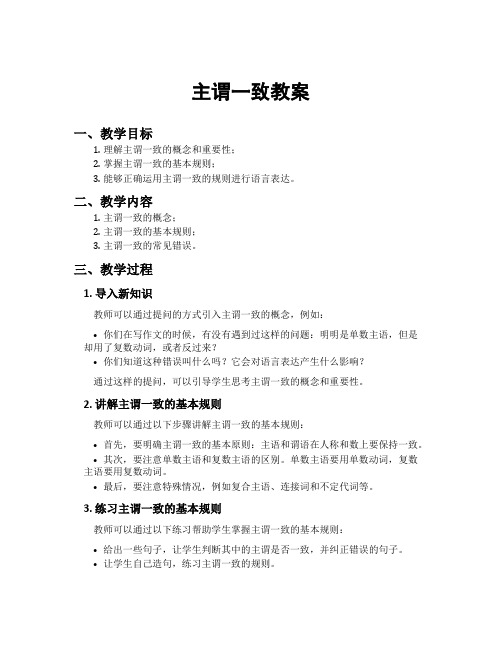
主谓一致教案一、教学目标1.理解主谓一致的概念和重要性;2.掌握主谓一致的基本规则;3.能够正确运用主谓一致的规则进行语言表达。
二、教学内容1.主谓一致的概念;2.主谓一致的基本规则;3.主谓一致的常见错误。
三、教学过程1. 导入新知识教师可以通过提问的方式引入主谓一致的概念,例如:•你们在写作文的时候,有没有遇到过这样的问题:明明是单数主语,但是却用了复数动词,或者反过来?•你们知道这种错误叫什么吗?它会对语言表达产生什么影响?通过这样的提问,可以引导学生思考主谓一致的概念和重要性。
2. 讲解主谓一致的基本规则教师可以通过以下步骤讲解主谓一致的基本规则:•首先,要明确主谓一致的基本原则:主语和谓语在人称和数上要保持一致。
•其次,要注意单数主语和复数主语的区别。
单数主语要用单数动词,复数主语要用复数动词。
•最后,要注意特殊情况,例如复合主语、连接词和不定代词等。
3. 练习主谓一致的基本规则教师可以通过以下练习帮助学生掌握主谓一致的基本规则:•给出一些句子,让学生判断其中的主谓是否一致,并纠正错误的句子。
•让学生自己造句,练习主谓一致的规则。
4. 指出主谓一致的常见错误教师可以通过以下方式指出主谓一致的常见错误:•给出一些常见的错误句子,让学生找出其中的错误,并纠正。
•让学生自己找出自己写作中的主谓一致错误,并进行改正。
四、教学反思主谓一致是语言表达中非常重要的一点,它关系到语言的准确性和流畅性。
在教学中,我通过提问、讲解、练习和指出错误等方式,帮助学生掌握了主谓一致的基本规则和常见错误。
在教学过程中,我发现学生对于主谓一致的概念和重要性有了更深入的理解,也能够更加准确地运用主谓一致的规则进行语言表达。
在今后的教学中,我还需要不断总结经验,不断改进教学方法,帮助学生更好地掌握语言表达的技巧。
高中英语_主谓一致教学设计学情分析教材分析课后反思

主谓一致教学设计一、教材分析:主谓一致在英语教学中占据重要地位,它是英语中最主要的语法之一,掌握好主谓一致,对学生们的阅读能力和理解能力有着极大的帮助。
二、学情分析:教学对象为高中一年级学生,对于学习英语语法存在惧怕心理,很难作为课堂活动的主体主动参与教师所设计的课堂活动。
因此,单纯的枯燥乏味的语法知识的讲解难以获得良好的教学效果,在主谓一致的讲解中积极设置语境、注重对学生语用意识和情感意识的培养尤为重要。
另外,本班学生学习水平良莠不齐,在教学活动的设计过程中应兼顾各个层次的学生,使他们学有所获。
三、教学目标:知识与技能:1. 学生能够了解主谓一致的使用规则2. 学生能够在日常学习及交往中根据主谓一直原则恰当表达。
3. 情感、态度与价值观:学生能够逐步了解主谓一致的用法并能恰当使用,培养学生对英语学习的兴趣。
四、教学重点:主谓一致的概念、规则。
五、教学难点:个体一致、语法一致、就远原则、就近原则。
六、教学方法:提问、小组活动七、教学手段:多媒体和学生学习支持材料八、教学过程:Step1: Leading-in1. What he said and what he did (be) different.What parents say and do (have) a life-long effect on their children.2. A number of new books (be) on the desk.The number of students in your class (be) 50.Step 2: Self-learning and pairwork1. Go though the grammar on P10 in the workbook.2. Discuss any problems in pairs or groups.Step 3: Explanation and improvement㈠就近一致(2点)1. )Here the bus. (come)2. )There some pens and a knife on the desk. (be)3. )There a knife and some pens on the desk. (be)1. )Neither the students nor the teacher _______ (know) anything about it2. )He or you (have) taken my pen.3. )Not only I but also David and Iris ______ fond of playing basketball.A. amB. isC. areD. was㈡语法一致原则(5点)1. 主语+with ( together with, along with, other than as well as, besides, except, but, like …)+n. /pron. 结构中,谓语与主语一致(就远原则)1.)Interest, as well as prospects(发展前景)____ important when one looks for a job.A. areB. wereC. isD. was2.)The students with their teacher (come) into the classroom together.2. 单一概念的不定式,动名词或从句作主语,谓语动词用单数1.) Serving the people (be) my great happiness.2.) It (be) important to learn English well.3.) When and where we will go hasn’t been decided.*当what引导的句子做主语,若后面是“be +名词/形容词”的结构时,谓语随名词变化。
初中主谓一致的简单教案
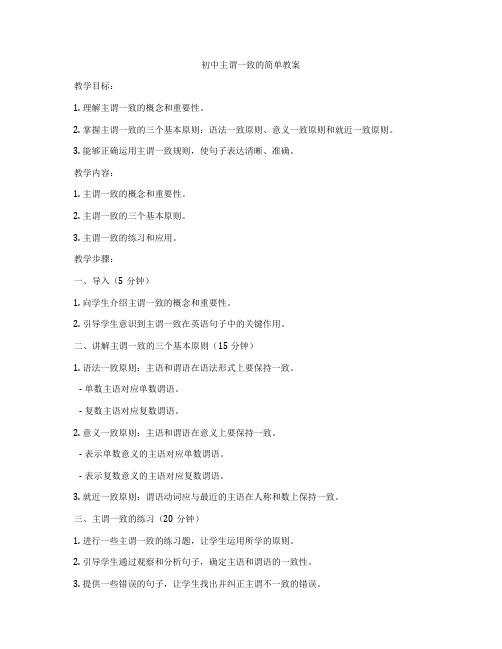
初中主谓一致的简单教案教学目标:1. 理解主谓一致的概念和重要性。
2. 掌握主谓一致的三个基本原则:语法一致原则、意义一致原则和就近一致原则。
3. 能够正确运用主谓一致规则,使句子表达清晰、准确。
教学内容:1. 主谓一致的概念和重要性。
2. 主谓一致的三个基本原则。
3. 主谓一致的练习和应用。
教学步骤:一、导入(5分钟)1. 向学生介绍主谓一致的概念和重要性。
2. 引导学生意识到主谓一致在英语句子中的关键作用。
二、讲解主谓一致的三个基本原则(15分钟)1. 语法一致原则:主语和谓语在语法形式上要保持一致。
- 单数主语对应单数谓语。
- 复数主语对应复数谓语。
2. 意义一致原则:主语和谓语在意义上要保持一致。
- 表示单数意义的主语对应单数谓语。
- 表示复数意义的主语对应复数谓语。
3. 就近一致原则:谓语动词应与最近的主语在人称和数上保持一致。
三、主谓一致的练习(20分钟)1. 进行一些主谓一致的练习题,让学生运用所学的原则。
2. 引导学生通过观察和分析句子,确定主语和谓语的一致性。
3. 提供一些错误的句子,让学生找出并纠正主谓不一致的错误。
四、主谓一致的应用(10分钟)1. 让学生练习编写一些句子,注意主谓一致的运用。
2. 鼓励学生运用主谓一致的规则,使句子表达清晰、准确。
五、总结和复习(5分钟)1. 对本节课的主谓一致教学进行总结。
2. 强调主谓一致在英语写作和口语表达中的重要性。
教学评估:1. 通过课堂练习和课后作业,评估学生对主谓一致的理解和应用能力。
2. 观察学生在口语表达和写作中的主谓一致运用情况,及时进行指导和纠正。
教学资源:1. PPT或黑板,用于展示主谓一致的规则和例子。
2. 主谓一致练习题,用于巩固所学知识。
教学反思:本节课通过讲解主谓一致的概念和重要性,以及主谓一致的三个基本原则,帮助学生理解和掌握主谓一致的规则。
通过练习和应用,学生能够更好地运用主谓一致的规则,使句子表达清晰、准确。
主谓一致教案

主谓一致教案主题:主谓一致的概念和规则引言:主谓一致是语法中的基本规则之一,它要求主语与谓语在人称和数上保持一致。
正确的主谓一致可以使句子更加清晰,避免歧义和语法错误。
本教案将介绍主谓一致的概念和规则,并提供练习来帮助学生巩固所学内容。
一、主谓一致的基本概念主谓一致指的是句子中的主语与谓语在人称和数上保持一致。
主谓一致是英语语法中的基本规则,它能够帮助我们准确表达意思,避免语法错误。
二、主谓一致的规则1. 当主语为单数第三人称(he、she、it、单数名词)时,谓语动词要用单数形式。
例如:He sings every day.(他每天都唱歌。
)2. 当主语为复数(they、we、you、复数名词)时,谓语动词要用复数形式。
例如:They play basketball every week.(他们每周打篮球。
)3. 当主语由单数和复数组成时,谓语动词的形式取决于靠近谓语动词的主语。
例如:The dog and the cats are sleeping.(狗和猫正在睡觉。
)4. 当主语为不可数名词时,谓语动词需要用单数形式。
例如:The water is cold.(水很凉。
)5. 当主语以及同位语(位于名词后面,对主语进行解释或说明的词语)指的是同一个事物时,谓语动词要与同位语的数保持一致。
例如:My favorite food is noodles.(我最喜欢的食物是面条。
)三、练习题1. The girl ______ (play/plays) the piano every day.2. They ______ (is/are) going to the park tomorrow.3. This book ______ (belong/belongs) to me.4. My brother and I _____ (like/likes) to watch movies.5. Tom ______ (has/have) a cat and a dog.答案:1. plays2. are3. belongs4. like5. has四、扩展练习请将下列句子中的动词正确地与主语保持一致。
幼儿园小小语法达人——主谓一致教案

幼儿园小小语法达人——主谓一致教案教案名称:幼儿园小小语法达人——主谓一致教案适用年龄:3-6岁教材及辅助材料:课本、图片、玩具教学目标:1. 了解主谓一致的概念。
2. 学习动词的单复数形式。
3. 能够正确运用主谓一致的规则。
4. 训练幼儿口头表达和写作的能力。
教学重点:1. 主谓一致的基本规则。
2. 动词的单复数形式。
教学难点:如何使幼儿掌握主谓一致的规则,提高幼儿口头表达和写作的能力。
教学过程:一、引入(10分钟)1. 教师用玩具或图片引导幼儿进行问答:T:大家看这个小猴子在干什么?S:跳舞!T:好的,这个小猴子在跳舞。
那如果我说“这个小猴子在跳舞”,对不对呢?S:对!T:如果我说“这个小猴子在跳舞们”,对不对呢?S:不对!2. 介绍本节课的主题——主谓一致。
让幼儿了解这个规则的重要性。
二、讲授(20分钟)1. 引导幼儿进行问答,帮助幼儿了解什么是主谓一致。
T:你们知道什么是主谓一致吗?S:不知道。
T:那我们来做一个小游戏,我会给你们两个单词,一个是主语,一个是动词。
你好好听我念,然后回答问题。
T:猫爬__ (树)S:树。
T:狗喜欢__ (玩)S:玩。
T:小鸟唱__ (歌)S:歌。
T:好了,你们猜猜这些单词有什么共同点?S:有空格!T:对呀,这些单词都有一个空格,这个空格是什么?(教师点出这个空格)S:是谓语。
T:对,非常好。
这个空格表示的是一个动作,我们把这个动作叫做谓语。
我们发现,这个谓语要和前面的主语“猫”、“狗”、“小鸟”形成一个完整的语句,这就是主谓一致。
2. 理解动词的单复数形式。
T:那么,除了主谓一致,我们还需要了解一些动词的单复数形式。
比如说:T:我吃了一个苹果。
T:我们吃了两个苹果。
这两句话有什么区别呢?S:“吃”变成了“吃了”。
T:对。
还有“一个”变成了“两个”,这些都是因为谓语动词和名词的单复数形式要相一致。
3. 讲解主谓一致的规则,举例说明。
T:那么现在,我们一起来回顾一下主谓一致的规则。
英语第三人称单数主语与谓语动词的一致性教学
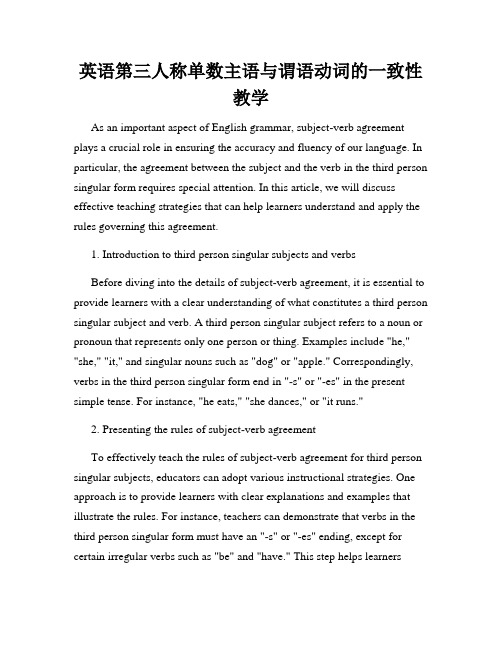
英语第三人称单数主语与谓语动词的一致性教学As an important aspect of English grammar, subject-verb agreement plays a crucial role in ensuring the accuracy and fluency of our language. In particular, the agreement between the subject and the verb in the third person singular form requires special attention. In this article, we will discuss effective teaching strategies that can help learners understand and apply the rules governing this agreement.1. Introduction to third person singular subjects and verbsBefore diving into the details of subject-verb agreement, it is essential to provide learners with a clear understanding of what constitutes a third person singular subject and verb. A third person singular subject refers to a noun or pronoun that represents only one person or thing. Examples include "he," "she," "it," and singular nouns such as "dog" or "apple." Correspondingly, verbs in the third person singular form end in "-s" or "-es" in the present simple tense. For instance, "he eats," "she dances," or "it runs."2. Presenting the rules of subject-verb agreementTo effectively teach the rules of subject-verb agreement for third person singular subjects, educators can adopt various instructional strategies. One approach is to provide learners with clear explanations and examples that illustrate the rules. For instance, teachers can demonstrate that verbs in the third person singular form must have an "-s" or "-es" ending, except for certain irregular verbs such as "be" and "have." This step helps learnersinternalize the rules and apply them correctly in their own speech and writing.3. Engaging learners through interactive activitiesTo reinforce the understanding of subject-verb agreement, teachers can engage learners in interactive activities. For example, educators can create fill-in-the-blank exercises or sentence completion tasks where learners must choose the correct verb form for a given third person singular subject. Additionally, teachers can organize classroom discussions or group work activities that require learners to use the appropriate verb forms in a communicative context. These activities encourage active participation and foster a deeper understanding of the subject-verb agreement rules.4. Providing ample practice opportunitiesRegular practice is essential for learners to master subject-verb agreement with third person singular subjects. Teachers can provide learners with worksheets, online exercises, or handouts that offer numerous practice questions related to this grammar topic. It is crucial to design exercises that cover various verb forms and provide opportunities for learners to apply the rules in different sentence structures. By offering regular and diverse practice opportunities, learners can build their confidence and proficiency in subject-verb agreement.5. Error correction and feedbackAs learners practice subject-verb agreement with third person singular subjects, it is essential for teachers to provide constructive feedback. During in-class activities or while reviewing practice exercises, teachers can identifyand correct any errors in verb forms made by learners. Moreover, teachers can explain the reasons behind the corrections and offer additional examples to clarify any misunderstandings. This type of feedback ensures that learners have a clear grasp of the subject-verb agreement rules and can apply them accurately.6. Integration into communicative contextsWhile mastering subject-verb agreement rules is crucial, it is equally important for learners to transfer this knowledge to real-life communicative contexts. Teachers should encourage learners to use the correct verb forms in their speaking and writing tasks, emphasizing the importance of accuracy in expressing ideas. By integrating subject-verb agreement into various language skills, such as conversation practice, role plays, or essay writing, learners can develop a natural and intuitive understanding of how to apply the rules in real-time communication.ConclusionIn conclusion, teaching subject-verb agreement with third person singular subjects is a vital aspect of English language education. By providing clear explanations, interactive activities, ample practice opportunities, error correction, and integration into communicative contexts, educators can effectively guide learners in understanding and applying the rules of subject-verb agreement. Developing proficiency in this area enhances learners' overall language skills and contributes to their fluency and accuracy in English communication.。
主谓语一致公开课课件
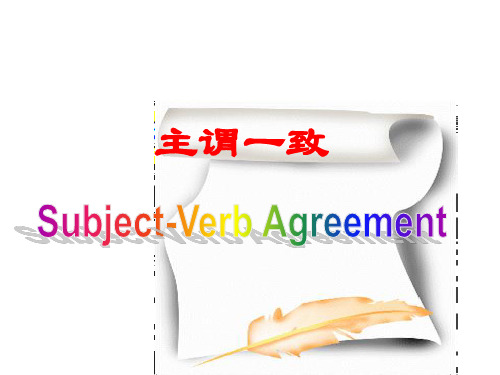
(3)由山脉、群岛、瀑布、运动会等以s结尾的 专有名词作主语。
The Olympic Games are held once every ur years.
(4)a number of/quantities of/a group of+ 名词作主语。
BCA
8. Barbara is easy to recognize as she’s the only one of the women who____ evening dress.(10全国2)
A. wear B. wears C. has worn D. have worn
9. It is reported that many a new house at present in the disaster area. (10陕西)
with a stranger.有各种各样的 (3) “kind,sort,pair,type+名词”作主语,以这
些名词本身的单复数而定。
This kind of paper_is__m_a_d_e__o_f _s_tr_a_w(用草生产的).
Some kinds of animals a_r_e_d_y_i_n_g_o_u_t(将要灭绝).
no/each/every/many a+单数名词”作主语。
More than one+单数可数名词
No teacher and no student _i_s_(be) in the classroom. Every pen and every book _h_a_s_b_e_e_n__la_i_d__ ( lay ) on the desk already.
主语和谓语的一致

主语和谓语的一致8.1 主语和谓语的一致主语和谓语的一致一般涉及三个原则:语法一致原则( Grammatical Concord ) - 即形式上的一致或动词和主语的数互相匹配。
如:The taboo against eating pork occurs in more than one culture. 不止一种文化有忌食猪肉的风俗。
(B2-U1-L39)意义一致原则( Notional Concord ) - 即意义或意念上的一致或按照数的概念动词与主语相一致。
如:Danish bacon and eggs makes a good solid English breakfast. 丹麦式的熏咸肉加鸡蛋做成了一顿美味的英国早餐。
邻近性原则( Principal of Proximity ) - 即动词不与主语中主要的词语相一致,而与最邻近它的词语相一致。
如:Either your brakes or your eyesight is at fault. 要么是你的刹车,要么是你的视力出了毛病。
8.1.1 单个名词作主语时的主谓一致1.集体名词,如army, audience, bacteria, band, board, brood, cabinet, cast, class, club, committee, community, company, council, couple, crew, crowd, data, enemy, faculty, family, flock, gang, government, group, herd, household, jury, media, navy, nobility, opposition, party, personnel, press, public, school, society, staff, team等作主语,动词的形式常取决于说话者或写作者的意图。
- 1、下载文档前请自行甄别文档内容的完整性,平台不提供额外的编辑、内容补充、找答案等附加服务。
- 2、"仅部分预览"的文档,不可在线预览部分如存在完整性等问题,可反馈申请退款(可完整预览的文档不适用该条件!)。
- 3、如文档侵犯您的权益,请联系客服反馈,我们会尽快为您处理(人工客服工作时间:9:00-18:30)。
主语和谓语的一致主语和谓语的一致⒈ Definition: 主语要和谓语在人称和数上保持一致叫主谓一致。
⒉主谓一致包括三个原则:语法一致原则、意义一致原则和就近一致原则。
㈠语法一致原则:指用作主语的名词词组的中心词和谓语动词在单复数形式上的一致。
⑴介词短语 with, as well as, including, except, except for, but, together, besides, rather than, along with, together with 等修饰主语时,谓语动词的数的形式与介词前面的名词或代词的人称和数保持一致。
e.g. I, along with my parents, am a football fan. The girl as well as boys likes playing basketball.⑵由each 和 every 修饰的名词以及由 every-, any-, some-, no- 构成的复合代词都当作单数,谓语动词用单数。
e.g. Every hour and every minute is important. Every boy and every girl enjoys the holiday. Someone is waiting for you. Everyone is here. Everything is ready.⑶动名词(短语),不定式(短语)和从句作主语,谓语动词用单数形式。
e.g. To see is to believe. Walking on the moon is very difficult. What he said is wrong.注:ⅰ. 在用形式主语it 的句中和在用it 作主语的强调句中,谓语动词总用单数。
e.g. It isn’t obvious who will be the best.It was he who taught us English last year.ⅱ. what 引导的主语从句,谓语一般用单数,但如果表示复数意义时谓语动词要用复数。
e.g. What he left me are some old books.ⅲ. 定语从句中谓语动词的单复数和先行词保持一致,但如果先行词受到 one of 的修饰时定语从句的谓语动词用复数,谓语动词受到the only (very, last) one of 的修饰时定语从句的谓语动词用单数。
e.g. He has some books which were bought yesterday. He is one of the students who have passed the exam.He is the only one of the students who has passed the exam.⑷ many a + n.(单数)/ more than one +n.(单数) 作主语时,谓语动词用单数。
e.g. More than one student likes the popular song- Fly Freely.Many a boy and many a girl has been to Beijing.⑸ a number of , a good/ great many, quite a few, scores of 加可数名词的复数形式时,谓语动词用复数; a large amount of, a great deal of 加不可数名词时,谓语动词用单数;a lot of, lots of, a quantity of, plenty of 等后面如果接可数名词复数形式时,谓语用复数形式, 如果接不可数名词时谓语动词用单数形式; amounts of…, masses of…, quantities of…, varieties of 无论后接什么名词,谓语动词都要用复数形式。
注:the number of +n.(pl.)谓语动词用单数形式。
⑹分数和百分数作主语时,谓语动词的单复数形式取决于of后面名词的形式。
e.g. One third of the books are worth reading. 20% of the students are absent today.⑺ kind/ sort/ type/ form/ series/ species of + n. 作主语时,谓语动词形式取决于这些名词的单复数而不是它们后面的名词。
e.g. This new type of buses is new on show. (但 Buses of this kind are new on show.)All kinds of difficulties have to be over come.㈡意义一致原则:指在意义上,主语的单复数形式需要与谓语动词的单复数形式保持一致。
有时主语形式虽为单数,但意义为复数。
⑴主语是 the people, the police, the public, the cattle, the youth 等集体名词,谓语动词用复数形式。
e.g. The police are questioning everyone in the house.⑵集体名词army, audience, enemy, family, committee, company, public, couple, group, staff, crew, team等,若作“整体” 对待,谓语动词用单数形式,若着眼于其中各个成员,谓语动词用复数形式。
e.g. The couple is talking with their son. The team are cheering for their success.⑶主语是“the+ adj.” 表一类人或物时,谓语动词用复数形式。
如the old, the young, the rich, the poor, the wounded.e.g. the old are taken care of here.⑷表时间、金钱、距离、温度、度量等复数名词作主语时,具有“整体” 概念,谓语动词用复数形式。
e.g. Two years is enough. A hundred miles is a long distance.⑸一些由两个相同部分组成一个整体的复数名词,如glasses, shoes, trousers, scissors 等作主语时,如主语前有“一条” “一把” “一双”等量词修饰,则谓语动词用单数形式,如主语前是复数修饰语或没有修饰语,谓语用复数形式。
e.g. This pair of shoes is Tom’s. The shoes are Tom’s.⑹以“-ics”和“-s”结尾的表学科的名词和不可数名词作主语时,谓语用单数形式。
(news, plastics, wroks等)。
e.g. Physics is not easy to learn. Plastics is a kind of matter.⑺两个名词由and 或both…and…连接作主语时,谓语动词一般用复数形式,但当and 不表并列意义,连接两个在意义上表同一人、物或概念或由两个部件配成的物品时,谓语动词用单数形式。
e.g. My brother and I have both seen the film. Both rice and wheat are grown in China.The professor and writer is speaking at the meeting. One more knife and fork is needed.War and peace is a long theme in history.⑻表示国家、城市、人名、书名、报纸、杂志及组织等的专有名词作主语,常作为整体看待,谓语动词用单数形式。
e.g. Shanghai is the biggest city in China. The United States lies in North America.⑼表示国家、民族的形容词与the连用,指整个民族,有多数的含义,谓语动词用复数形式,但表语言时用单数。
e.g. The French are brave. French is a beautiful language.⑽ “a+单数名词+or two”作主语,谓语动词用单数形式,但“one or two+复数名词” 作主语,谓语动词用复数形式。
e.g. A day or two has passed. One or two days have passed.⑾两个主语,一个表肯定,另一个表否定,谓语动词的数与表肯定的主语一致。
e.g. I, not you, am the right person to do the work.⑿一些以复数形式出现的单复同形名词,作主语时,其谓语动词的单复形式要根据句子的具体含义来定,常见的这类以复数形式出现的单复同形词有:means(方法,手段),bellows(风箱,减压舱), species(种类), series(系列),works(工厂), barracks(兵营,营房),lazybones(懒骨头), headquarters(司令部),gallows(绞台),links(高尔夫球场).e.g. One means \Every means has been tried. All means \Such means are unpleasant.⒀英语中有些单复数同形的名词是以单数形式出现的,这些词主要有下面几种:ⅰ. 某些动物名称:sheep,deer等。
ⅱ. 以“-ese”或“-ss” 结尾的国家名称:Chinses, Japanese, Swiss等。
ⅲ. 汉语音译的表示度量衡、货币等单位的名称:jin(斤), yuan(人民币元)等。
ⅳ. craft(指船或飞机),aircraft(飞机)等。
注:有时此类动物名称加“-s”表示不同种类:e.g. two fish (同种)两条鱼 two fishes 两条不同的鱼㈢就近一致原则:指谓语动词的单复数形式取决于最靠近它的名词或代词的单复数形式保持一致。
⑴由or, either…or…, neither…nor…,not only…but also…,not…but…连接的并列主语。
e.g. Either Tom or you are going to help us.Not only the students but also the teacher is enjoying the film.⑵在there be和here be 表“存在”的结构中,谓语动词与最近的主语保持一致。
